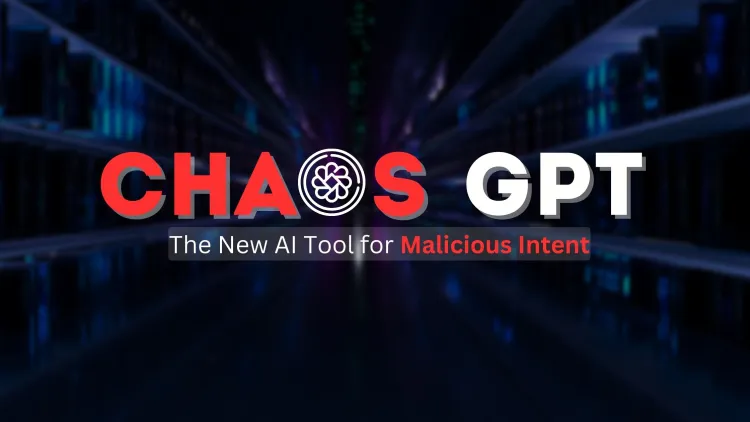What is Chaos GPT ? The New AI Tool for Malicious Intent
Chaos GPT is a malicious AI tool that represents a significant threat to cybersecurity. Unlike ChatGPT, which is designed to assist with tasks in a helpful and responsible manner, Chaos GPT lacks safeguards and is instead used by cybercriminals to generate harmful content like phishing emails, malicious code, and fake websites. Sold on illicit platforms like the dark web, it allows attackers to carry out sophisticated attacks with speed and precision. As the risk from AI-driven tools like Chaos GPT grows, it is essential for organizations to adopt robust cybersecurity practices. This includes advanced threat detection, employee education, multi-factor authentication (MFA), and continuous monitoring to mitigate the risks posed by such malicious tools. The key takeaway is that while AI can be a powerful ally for improving cybersecurity, it can also be exploited by cybercriminals. To protect sensitive data and maintain trust, proactive vigilance and the responsible use of AI technologie

Artificial Intelligence (AI) has revolutionized industries, empowering businesses and individuals with innovative tools like ChatGPT. However, alongside the many benefits AI offers, there has also been a darker side that threatens cybersecurity. Chaos GPT is one such tool designed for malicious purposes, enabling cybercriminals to conduct sophisticated attacks. In this blog, we’ll explore what Chaos GPT is, how it works, its implications for cybersecurity, and best practices for mitigating its risks.
What is Chaos GPT?
Chaos GPT is a malicious AI tool used by cybercriminals to automate and enhance their attacks. Unlike ChatGPT, which adheres to ethical guidelines to avoid harmful content, Chaos GPT operates without restrictions, making it an attractive tool for creating phishing emails, malicious scripts, and other forms of cyberattacks.
Chaos GPT is often distributed through illicit channels such as the dark web and Telegram. It leverages advanced AI to craft harmful content with incredible speed and efficiency. This tool has been gaining traction in the world of cybercrime, marking a significant evolution in how attackers carry out their operations.
How Does Chaos GPT Work?
Chaos GPT operates similarly to other AI chatbots, but with the key difference that it has no safeguards in place. While ChatGPT is designed to provide useful and responsible answers, Chaos GPT is tailored to generate content for malicious purposes.
Key Features and Capabilities of Chaos GPT
-
Phishing and Social Engineering:
- Chaos GPT can create realistic phishing emails, SMS messages, or social media communications. These messages are designed to deceive targets into disclosing sensitive information such as usernames, passwords, and financial data.
-
Malicious Code Generation:
- The tool can also generate malware and other harmful scripts that cybercriminals use to compromise systems, steal data, or cause damage to networks.
-
Fake Websites and Landing Pages:
- Chaos GPT can create fake websites that mimic legitimate pages like banking or shopping sites. These counterfeit pages are designed to trick victims into entering personal information, which can then be exploited by the attacker.
-
Targeting Specific Industries:
- Chaos GPT allows cybercriminals to customize their attacks by targeting specific industries. This feature enables attackers to focus on vulnerabilities unique to certain sectors, enhancing the success rate of their attacks.
-
Spreading Misinformation:
- The tool can also be used to spread misinformation, which can create chaos, manipulate public opinion, and fuel disinformation campaigns, further increasing its malicious potential.
Implications for Cybersecurity
The emergence of tools like Chaos GPT represents a growing threat to cybersecurity. With its ability to rapidly generate malicious content and exploit vulnerabilities, Chaos GPT makes it easier for cybercriminals to execute sophisticated attacks that were once reserved for highly skilled hackers.
Key Cybersecurity Challenges
-
Accelerated Attack Timelines:
- Cybercriminals can use Chaos GPT to generate malicious content in seconds, allowing them to execute attacks faster and more frequently. This reduces the time available for defense teams to detect and respond.
-
Increased Sophistication of Attacks:
- The content generated by Chaos GPT is highly convincing and can easily bypass traditional security measures. As these attacks become more sophisticated, it will be harder for organizations to identify and mitigate them.
-
Erosion of Trust:
- The use of AI in creating realistic phishing campaigns and other malicious attacks can lead to a general erosion of trust in online communications. This loss of trust can make it easier for cybercriminals to execute successful attacks, such as data breaches or fraud.
Best Practices to Mitigate the Risk of Chaos GPT
As AI-powered tools like Chaos GPT continue to evolve, it’s crucial for both individuals and organizations to adopt robust cybersecurity practices to mitigate the risks associated with them. Below are some best practices to help protect against AI-driven attacks.
Recommended Cybersecurity Practices
-
Implement Advanced Threat Detection Systems:
- Use advanced threat detection systems capable of identifying AI-generated content, including phishing emails, fake websites, and malware. Machine learning models that recognize patterns in malicious content can enhance security measures.
-
Educate Employees and Users:
- Regularly train employees and users on how to recognize phishing attempts, social engineering tactics, and suspicious activities online. The more aware they are, the less likely they are to fall for AI-generated attacks.
-
Regular Software Updates and Patching:
- Keeping all systems, applications, and software up-to-date is essential to close security gaps. Regular security patches prevent cybercriminals from exploiting known vulnerabilities.
-
Enable Multi-Factor Authentication (MFA):
- Enable multi-factor authentication (MFA) across all systems and platforms. This adds an extra layer of security, making it harder for attackers to gain unauthorized access to systems, even if they’ve successfully stolen login credentials.
-
Monitoring and Incident Response:
- Develop a comprehensive incident response plan that outlines steps to take when an attack is detected. Proactive monitoring allows security teams to identify potential threats before they cause significant damage.
The Dual Nature of AI: Opportunities and Threats
While Chaos GPT demonstrates how AI can be exploited for malicious purposes, it’s also important to recognize that AI can be used defensively. Cybersecurity professionals can leverage AI to detect threats, automate responses, and strengthen defenses.
However, the increasing sophistication of AI-driven attacks means that cybersecurity professionals must continuously adapt and improve their security strategies. As AI technologies evolve, so too will the methods used by cybercriminals to exploit them.
Conclusion
Chaos GPT serves as a stark reminder of the growing risks posed by AI-driven cyberattacks. As tools like Chaos GPT become more advanced and accessible, cybercriminals will be able to carry out attacks with unprecedented speed, sophistication, and efficiency.
To combat these evolving threats, it’s crucial for individuals and organizations to stay informed, adopt advanced cybersecurity practices, and use AI responsibly. As the battle between cybercriminals and cybersecurity defenders intensifies, the key to protecting sensitive data and systems lies in proactive vigilance and continuous adaptation to new technologies.
FAQs
-
What is Chaos GPT?
- Chaos GPT is a malicious AI tool used by cybercriminals to generate phishing emails, malware, and fake websites to facilitate cyberattacks.
-
How does Chaos GPT differ from ChatGPT?
- Unlike ChatGPT, which has built-in safeguards, Chaos GPT operates without restrictions, making it suitable for creating harmful content and cyberattacks.
-
Where is Chaos GPT sold?
- Chaos GPT is often sold on dark web marketplaces and other illicit platforms like Telegram.
-
What can Chaos GPT be used for?
- Chaos GPT can be used to generate phishing emails, malware, social engineering attacks, fake websites, and more to exploit vulnerabilities.
-
Is Chaos GPT legal to use?
- No, Chaos GPT is a malicious tool used for illegal activities, including cybercrime, and its use is illegal.
-
What industries are most at risk from Chaos GPT?
- Chaos GPT can target any industry, but financial institutions, e-commerce platforms, and organizations with weak security protocols are most vulnerable.
-
How can Chaos GPT affect a business?
- Chaos GPT can compromise sensitive data, cause financial losses, and damage an organization's reputation through successful cyberattacks like phishing.
-
What cybersecurity measures should organizations take against Chaos GPT?
- Organizations should implement advanced threat detection systems, train employees, enable multi-factor authentication (MFA), and keep systems updated to prevent attacks.
-
Can Chaos GPT be used for misinformation campaigns?
- Yes, Chaos GPT can be used to generate fake news, spread misinformation, and manipulate public opinion, which can exacerbate its malicious effects.
-
How can AI be used to protect against tools like Chaos GPT?
- AI can be leveraged to detect and block AI-generated content, automate threat responses, and strengthen overall cybersecurity defenses.














![Top 10 Ethical Hackers in the World [2025]](https://www.webasha.com/blog/uploads/images/202408/image_100x75_66c2f983c207b.webp)








